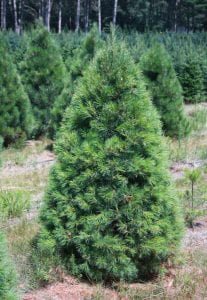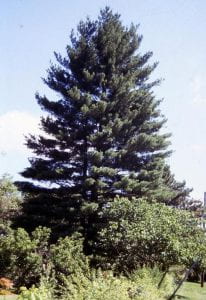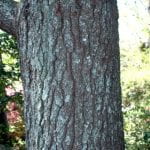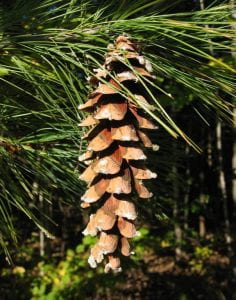“O Christmas Tree”
by Becky Stage, Florida Master Gardener Volunteer
 It is believed that the Christmas tree originated in Latvia in the early 1500s and the tradition was brought to the United States by German settlers in the 1800s. It was originally tabletop size but soon became floor to ceiling size. Christmas trees started to be sold commercially in the United States in 1851. At that time, Christmas trees were harvested from forests. Eventually conservationists became concerned that the natural supply of evergreens was being decimated, which lead to the creation of Christmas Tree Farms. The first Christmas Tree Farm in the United States was started in New Jersey in 1901 and grew Norway spruce trees.
It is believed that the Christmas tree originated in Latvia in the early 1500s and the tradition was brought to the United States by German settlers in the 1800s. It was originally tabletop size but soon became floor to ceiling size. Christmas trees started to be sold commercially in the United States in 1851. At that time, Christmas trees were harvested from forests. Eventually conservationists became concerned that the natural supply of evergreens was being decimated, which lead to the creation of Christmas Tree Farms. The first Christmas Tree Farm in the United States was started in New Jersey in 1901 and grew Norway spruce trees.
The eastern white pine (Pinus strobus), also known as white pine, northern white pine, northern pine, and soft pine, is a very popular Christmas tree. It is native to New York and all of eastern North America, from Canada down to northern Georgia and Alabama.
 The eastern white pine is a very large tree, fifty to eighty feet tall and twenty to forty feet wide. It can often be identified by its lone silhouette as it towers over other trees in the forest or by its wide base and gradual layering of upswept branches up to the top. Pine trees are easy to distinguish from other conifers as they are the only conifer that has their needles bundled in sheaths known as fasicles. Eastern white pine needles are blue/green to silver/green in color and 2-5 inches long. It is easy to distinguish from other pines in our area, because it is the only one that has five needles in each fasicle.
The eastern white pine is a very large tree, fifty to eighty feet tall and twenty to forty feet wide. It can often be identified by its lone silhouette as it towers over other trees in the forest or by its wide base and gradual layering of upswept branches up to the top. Pine trees are easy to distinguish from other conifers as they are the only conifer that has their needles bundled in sheaths known as fasicles. Eastern white pine needles are blue/green to silver/green in color and 2-5 inches long. It is easy to distinguish from other pines in our area, because it is the only one that has five needles in each fasicle.
 Somewhere between 25-35 million live Christmas trees are sold in the United States each year. When grown as a Christmas tree, the eastern white pine is cut at six feet and is usually sheared. It takes 6-8 years to produce an eastern white pine Christmas tree whereas it takes other an average 15 years for other Christmas tree species making it very profitable for Christmas tree growers.
Somewhere between 25-35 million live Christmas trees are sold in the United States each year. When grown as a Christmas tree, the eastern white pine is cut at six feet and is usually sheared. It takes 6-8 years to produce an eastern white pine Christmas tree whereas it takes other an average 15 years for other Christmas tree species making it very profitable for Christmas tree growers.
The eastern white pine prefers to grow in locations that get lots of sun and have moist, sandy loam soils. It will tolerate some shade and although it will grow on rocky ridges and wet sphagnum bogs, it will not be as magnificent as when grown in its ideal conditions.

This pine excels as a Christmas tree as it has good to excellent needle retention and very little aroma which is a plus for those who suffer with allergies. On the down side, the branches do not support much weight and it is recommended not to put heavy ornaments on them.
The bark on young eastern white pine trunks and branches is smooth and tends to be greenish-brown in color. As the tree ages the bark becomes dark gray and deeply fissured. mo

All pines are gymnosperms, which means that they have neither flowers nor fruits. Instead of flowers they produce male and female cones. The seeds of conifers are not protected by a fruit, they are naked hence the name “gymnosperm” which comes from the Greek meaning “naked seed”.
Eastern white pines are monoecious meaning that both male and female cones occur on the same tree. Cones are produced in the spring with the male cones located near the bottom of the tree and the female flowers higher up on the tree. Pines are wind pollinated and the cone placement helps prevent self-pollination.

The female cones of the eastern white pine are 4-8 inches long and slightly curved. They start out green and become light brown as they ripen. After pollination, two seeds develop on top of each scale on the cone. The seeds mature at the end of the second season and drop out after the cone dries. Mature cones often remain attached to the tree for several months before they fall off.
The eastern white pine is very sensitive to air pollution and salt spray. It also is susceptible to insect pests include the white pine weevil, the white pine shoot borer, aphids, bagworms, bark beetles, sawflies, and scale. There are also several diseases that affect white pine trees.
If you are still looking for a Christmas tree, consider getting an eastern white pine. It is a beautiful tree with its soft, luxurious needles and low allergenic properties. And don’t forget to support our local farmers:
Christmas Tree Farms in Orange County New York
And if you are looking for great native tree to add to your landscape, eastern white pines are a great addition. You can plant a towering tree or a dwarf cultivar. They are commonly used as windbreaks and screen. And eastern white pines help support a wide range of wildlife providing both food and shelter to several mammal species and a whole host of bird species.

Resources
Basic Information
Eastern White Pine (Pinus strobus) – Woody Plant Database, Cornell University
Eastern White Pine (Pinus strobus) – Plant Database, University of Connecticut
Trees of the Adirondacks: Eastern White Pine (Pinus strobus) – Adirondacks Forever Wild
Care
Pruning Evergreens – Colorado State Extension
Pruning Pines – Michigan State University Extension
White Pine Planting and Care – Tending White Pine – Minnesota Department of Natural Resources
Problems
Dieback of Eastern White Pine – University of Massachusetts Extension
Eastern White Pine: Modern Disease Threats to a Historically Important Species – Penn State University
Eastern White Pine Problems – Missouri Botanical Garden
Pine Diseases – Penn State Extension
Pines: What’s Wrong with My Plant? – University of Minnesota Extension
White Pine Weevil – Colorado State Extension
